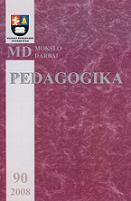Aukštesniųjų klasių moksleivių altruistinių ketinimų ypatumai
Peculiarities of Altruistic Intentions of Senior Pupils
Author(s): Aušra Stonytė, Irena GailienėSubject(s): Education
Published by: Vytauto Didžiojo Universitetas
Keywords: altruism; altruistic intentions; boundaries of intentions; motivation of altruism.
Summary/Abstract: This article analyzes the lack of altruistic behavior in the presentday society and its manifestation reflected by the intentions of senior pupils. The aim of the research was to find out the frequency of egoistic-altruistic behavior of the youngsters and their dependence on boundaries and approach to reality. Also it was aimed to assess the influence of help object and the sex of respondents to the expression of altruistic intentions. The research was carried out by two stages: first, the test with various situations when the persons need some help was used (in this test the altruistic intentions were not precisely limited); second, by the social provocation method the respondents were forced definitely to decide to help or not. 300 pupils of the X- XII forms from šiauliai have participated in this research. The results of the research have proved the hypothesis that the more altruistic intentions of the senior pupils were being limited and the more they were being approached to the reality, the more frequently this kind of intentions declined. More than two thirds of the respondents expressed their altruistic intentions (that is the wish to help other persons) in situations which did not require particular sacrifice of their interests for the sake of others, whereas few pupil remained willing to help in the situations, when altruistic intentions were limited. Only 26,30 % of the respondents agreed to participate in activity helping old people and even the half of the respondents intended to help only one time. Moreover, only 11 from 300 respondents would help the old people once in two weeks. It means that altruism even at the level of intentions is really low among senior pupils. According to the counting of correlation between the results of two stages of the research, it was found out that statistically reliably positive relation (r = 0,298; p < 0, 01) exists between unlimited altruistic intentions in separate situations and limited intentions in social provocation. Thus, it appeared to be clear the tendency that those pupils who intended to help the others in the situation test have the same intentions regarding the help for the old people and the opposite. This verifies the validity of the research instruments. The analyses of relation of egoistic-altruistic intentions allow to state that for the majority of the respondents altruistic intentions are characteristic in the situations which do not require particularly to sacrifice their interests for the sake of the other persons. Nonetheless, even in those situations more than one third of the respondents expressed their veiled egoistic intentions, which revealed masked by various excuses unwillingness to help the others. This concealment is induced by the social norms. Some pupils openly expressed their egoistic intentions.
Journal: Pedagogika
- Issue Year: 2008
- Issue No: 90
- Page Range: 91-97
- Page Count: 7
- Language: Lithuanian

